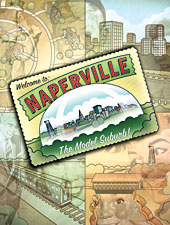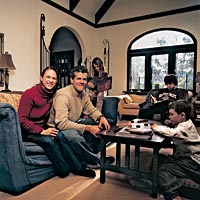|
Illustration By Peter and Maria Hoey |
When the Boeing Company announced it would move its headquarters to Chicago in 2001, John Dern, who worked in the company’s public-relations office, was one of about 150 employees who chose to come along. Dern, his wife, Erin, and their three kids enjoyed Queen Anne, their Seattle neighborhood-its diversity, its older homes, its proximity to downtown. So on a scouting mission to Chicago, they looked for a similar place, touring towns like Oak Park and Evanston.
After four days of finding nothing they liked and could afford, they took a second look at some brochures that their relocation consultant had given them about Naperville. The town seemed all wrong to them: too far from downtown, too full of brand-new houses, too white. “It was 30, 35 miles outside Chicago,” John Dern recalls. “Forget it.”
But they schlepped the kids out there anyway, and both recall being delighted that first morning to find that Naperville had a dynamic downtown of its own, a quick train commute into the Loop, and a broad range of housing. By lunchtime they had decided to move to Naperville. A few months later, they were settled into a lovely stucco house built in the 1920s near the center of town.
As the Derns suspected, Naperville does not have much racial diversity. The town is 85.2 percent white-but “at least it’s more diverse than we thought it would be,” John says. Erin recalls that at her oldest son’s recent junior high basketball double-header against another Naperville team, a third of the opposing players were not white. “That’s not bad for the suburbs,” she says. (In November, Naperville’s park district announced plans to install a cricket pitch in Commissioners Park; many Asian Americans love the sport-and they make up 9.6 percent of the town’s population.)
|
Photograph: Chris Guillen |
|
A successful transplant: Though skeptical at first, Erin and John Dern (shown with their three children inside their 1920s house) have fallen in love with Naperville since moving from Seattle in 2001. |
Naperville seduced the Derns the way it does thousands of new residents every year: it somehow manages to combine the Mayberry charm of a small town with an audacious eagerness to keep on growing (with a population of about 140,000, it is the third- largest city in Illinois). At a time when the country’s urban and exurban landscapes seem overrun with strip malls and placeless sprawl, Naperville-which endures its share of blemishes-suggests another way of living. “It’s a suburb that does all the suburban things, but slightly better,” says Robert Bruegmann, a professor of art history, architecture, and urban planning at the University of Illinois at Chicago and the author of the recent book Sprawl: A Compact History. “In Naperville there’s a placefulness that is missing from so many other suburbs.”
Bruegmann is not the only observer to recognize that Naperville is special-the town boasts a long string of awards. Among them: Money magazine rated Naperville the third-best place to live in America (2005); the U.S. Census Bureau called it the country’s best place to be a kid (2004); the AARP listed it as one of the top ten small towns for senior citizens (2000); Walking magazine put it on the list of the nation’s ten best walking towns (1999); and Na-perville’s public library system is a seven-time leader in the American Library Asso-ciation’s ranking of the nation’s best. Na-perville is also one of the best places in Illinois to find a job, with a cliff wall of corporate office buildings lining I-88, the Ronald Reagan Memorial Tollway (formerly the East-West Tollway). Last September Office Max announced that it would shift its headquarters from Ohio to Naperville, and the Northern Illinois Planning Commission projects 83,000 new jobs arriving by 2030, second only to Chicago among Illinois employment centers.
“Naperville is phenomenal, man, and it gets better every year,” says Scott Harris, the Chicago restaurateur whose popular chain, Francesca’s, has two sites in Naperville. When Harris visited Naperville for the first time, in 1994, he barely knew how to find the place, but like the Derns he finished the day ready to stake his claim. He later pushed his buddy Jimmy Bannos to open a branch of his Loop restaurant Heaven on Seven in Naperville, and now, after two years in his only suburban location, Bannos, too, is part of the lovefest. “The magic thing about this town,” says Bannos, seated in his Mardi Gras– themed dining room on Main Street, “is that it’s a city of, like, 150,000 people, with all the sophistication that gets you, but it still feels like a small town.”
For more than a century after its founding 175 years ago, Naperville was exactly that-a small town on a bend of the DuPage River. But just after World War II, it embarked on a 60-year spree of building new homes and offices, most of them for high-tech companies. Growth has slowed somewhat since the fevered 1980s, but Peter Burchard, the city manager, notes that more than 1,400 acres remain to be developed within the city limits.
The city’s land area is vast, stretching a little more than 12 miles from the corporate buildings on its northeastern edge in DuPage County (above I-88) to the last subdivision at its far southwestern tip below 111th Street in Will County. Driving from one end of town to the other-and you have little choice but to drive, Naperville’s key urban deficiency being public transportation-takes 35 minutes. When traffic cooperates.
But Naperville is still small, or at least it feels that way to many residents, thanks to its being a confederation of subdivisions. “When you meet somebody in Naperville, they don’t say, ‘Where do you live?’ They say, ‘What subdivision do you live in?'” says Robin Klau, who moved to Naperville-make that the Westwind Estates subdivision-five years ago with her husband, Rick.
Granted, this is not heaven. Naperville does have problems. Traffic creeps so slowly along most major avenues during rush hour that you might as well walk-when you can find a sidewalk. As Naperville’s mayor,
A. George Pradel, says, traffic is a problem that only seems to get worse. “My vision is a bus system that takes you anywhere at any time,” instead of Pace’s two fixed routes that run through town, he said, before noting that it’s not going to happen anytime soon. Of course, Naperville is not the only place where traffic is thickening.
As a quintessentially suburban place, Naperville may never win over the devoted cityphile. But for six decades it has rarely stopped drawing new people in with its stellar downtown, the go-go attitude of its schools and other institutions, and its curious supply of genial community spirit. In the 1990s alone, Naperville grew by half its own size, but that was meager relative to the 1980s, when it had doubled. (“Nobody ever thought it would be this big,” says Pradel, who has lived in Naperville since 1939, when he was two years old.) These things don’t happen by accident. In Naperville, Bruegmann observes, “it’s part hard work, part marketing, and part serendipity.”
|
Courtesy of Naperville Heritage Society Archives
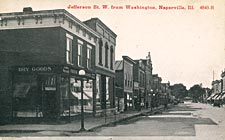 |
|
While most of the buildings along Jefferson Avenue (below) look much as they did in this 1915 photo (top), the sidewalk scene is livelier-and the car traffic decidedly more congested. |
|
Photo: Chris Guillen
 |
The epicenter of all things Naperville is its downtown, the envy of many a village planner. Its necklace of anchors and attractions supplies a steady stream of diners and shoppers who spent more than $213 million there in 2004. Beyond the cash the customers bring, they instill vibrancy into a district that is the public face of the town; a study by 4Insights, a Naperville-based marketing company, reported that 90 percent of real-estate agents surveyed said the downtown attracted new homebuyers, and 93 percent said it created preference over other towns and increased home values.
When they were scouting Chicago suburbs in 2001 because of a job change, San Franciscans Rick and Robin Klau discovered Naperville on the Internet, and driving into the downtown hooked them. “It was just remarkable, all there was downtown,” Rick Klau says. “We hadn’t even seen any houses yet, but we wanted to find one that would get us into this amazing town.”
Weightiest of the anchors is Naperville’s pleasurable Riverwalk, with its fountains and bridges, its ducks shooting the rapids, its carillon, sled hill, beach, woods, and other attractions. (See The Best of Naperville) The Riverwalk alone would probably generate healthy foot traffic downtown, but there’s also North Central College, Naperville Central High School, the Nichols Public Library, DuPage Children’s Museum, Edward Hospital, and the Naper Settlement historical re-creations and museum-all either attached to downtown or just a few blocks off it. Together, they pump a lot of people into a 16-square-block core that is a magnetic mix of antique and modern structures, chain and independent retailers, busy all the time and packed on weekend evenings.
“Go stand at Jefferson and Main on a Saturday night,” Harris says. “That’s a hot corner. You could be on Rush Street. The people, the traffic.” Within a few blocks, there’s live music at Frankie’s Blue Room, a scene at Sullivan’s Steakhouse, and another one at Hugo’s Frog Bar. Weekdays, the action is quieter, but not any slower. With some 51 restaurants and a panoply of boutiques, galleries, and furnishings stores, downtown Naperville keeps ’em coming.
Happenstance didn’t spark all this energy. Free parking did. In the mid-1970s, the subdivision edges of Naperville were growing at what then seemed a fast pace (subsequent decades would later make the 1970s look sluggardly), but the downtown area was “sleepy,” says Patti Roberts, head of the Naperville Business Alliance. Old-line Naperville shops heard their death knell ringing from seven miles away when the Fox Valley Mall opened on the eastern edge of Aurora, just outside western Naperville. City officials and business leaders “got together and made a very key decision in the life of downtown Naperville,” she says. “They got rid of all the parking meters, to compete with the mall on free parking. And parking has been free in Naperville ever since.”
Not that it’s easy. City-operated free lots-one on almost every block-and curbside parking often fill up, and downtown shoppers sometimes measure their time in loops, as in “It only took me two loops to find a spot.” Even so, the very fact that you can park free anywhere in downtown Naperville speaks to the city’s open-for-business attitude.
Developers, restaurateurs, and others say the city is aggressively friendly to new plans, for either residential or business proj-ects. “It’s been a really good climate for development the last 20 or 30 years,” says Dwight Yackley, a developer who moved to town in 1976. With his wife, Ruth, Yackley completed Main Street Promenade, a retail and office building at Main Street and Van Buren Avenue, in 2003, and is now building Benton Terrace, a complex of high-end condos. “In Naperville, they definitely want to get you in.”
The Other City on the Make
|
Photography: Aerial Images Photography
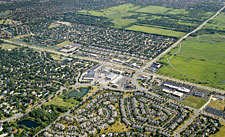 |
| An aerial photograph-looking southeast toward the intersection of 75th Street (running from left to right) and Plainfield-Naperville Road-reveals Naperville’s regimented subdivisions and the Springbrook Prairie Forest Preserve. |
If Nelson Algren hadn’t already tagged Chicago as the “City on the Make,” Naperville might warrant that sobriquet-though for the most part without Algren’s undercurrent of hustle and scam. A year older than Chicago, Naperville is similarly unashamed to pursue what it wants-whether it’s a neighboring town’s college (in 1870), an exit (50 years ago) on the East-West Tollway, or some 370 different pieces of land (annexed over a 45-year span). “It’s an opportunistic place, absolutely a place that is looking to grow,” says Ann Durkin Keating, a history professor at North Central College and one of the editors of The Encyclopedia of Chicago. “There’s always been this sense that Naperville is always looking to the next thing, to ‘What’s going to bring us forward?'”
Joseph Naper, a Great Lakes steamship captain, and his brother, John, arrived in the area now named after them in July 1831, to establish a claim Joseph had made on the land earlier that year. They started a sawmill and, with their partner, J. W. Peck, a trading post. When the Black Hawk War scared Peck the next year, they traded him some lots in downtown Chicago for his share in the store-evidently thinking Naperville was the better bet. John Naper left soon afterward to return to the seafaring life, but Joseph and his wife, Almeda, stuck around. By 1836, he was in the Illinois legislature, and in 1842 he laid out the streets of Naperville.
The incident that may have birthed Naperville’s bullish-on-business mindset came in 1867, when neighboring Wheaton, more successful at the time because it had a train stop and Naperville didn’t, got to take away the DuPage County seat. Naperville resisted, Keating explains, and eventually-legend has it-a gang of armed men from Wheaton launched a midnight raid to steal the county records that Naperville wouldn’t relinquish.
“That may have started it,” Roberts says. “When Wheaton came and stole the records, people in Naperville knew they needed to be more conscious of their community.” And perhaps stage a raid of their own, if a more genteel one: in 1870, Na-perville town leaders put up an impressive new limestone building and offered it free to Plainfield College-in Plainfield, the next town south-if the school would decamp to Naperville. The school obliged, and it lives today as North Central College. “There’s no question it was done to make real estate in Naperville more valuable,” Keating says. “It was an opportunistic deal.”
She sees the same attitude in the town’s aggressive courtship of the Illinois State Toll Highway Authority in the late 1950s. The route of the planned East-West Tollway went north of Naperville proper, but, Keating says, “Naperville really got that there would be a usefulness to that road, and they were open to it. Wheaton didn’t want it; Wheaton wanted to stay a small town. But Naperville said, ‘We’ll take it. Build us an exit ramp.'”
With the creation in 1946 of Argonne National Laboratory (near Lemont, about 15 miles southeast of Naperville) and the establishment, in 1967, of the National Accelerator Laboratory-now called Fermilab-in Batavia (about 15 miles northwest of town), Naperville was on its way to becoming “Chicago’s Technoburb,” as Lake Forest College history professor Michael Ebner later dubbed it. Bell Labs, Amoco, Nalco Chemical, NI-Gas, and Miles Laboratories were among the corporations that set up facilities in Naperville during the 1960s, ’70s, and ’80s.
And though many of them shrank or disappeared entirely in successive paroxysms of the tech revolution, Keating points out that Naperville is such a humming job engine that the loss of a big employer “is usually kind of like a blip, because Naperville is already tooling up for the next thing.” Such as Office Max’s headquarters, which-thanks to $20 million in incentives from Naperville and Illinois-will put some 1,500 employees in the former home of Lucent Technologies (an AT&T descendant) toward the end of this year.
Dedicated city dwellers might find Naperville’s dynamic downtown comfortably semiurban, but when they drive along a street like Rickert Drive, they enter their nightmare of suburban life. It’s a wide, curving boulevard between back fences. The impression is of driving along the bottom of a canal. No feeling of welcome here.
Like many modern towns, Naperville is a jigsaw puzzle of subdivisions whose streets twist back to meet themselves and may or may not connect to the next subdivision. In the antithesis of Chicago’s orderly grid, each subdivision is a separate bubble in the froth that emanates out from the town’s historical core.
|
Photography: Chris Guillen
 |
|
Naperville’s bustling downtown offers a wide array of shopping and dining opportunities. |
More than most towns, though, Naperville has put the inward-turning nature of subdivisions to a good end. Naperville’s versions are, first of all, smaller, more easily grasped units within a dizzying tangle of streets, places where neighbors feel they have a common interest they can get their arms around. “Human beings can only associate with so many others,” says Paul Lehman, the president of Macom Corp., a longtime Naperville developer now also building subdivisions in Plainfield and other neighboring towns. “If you live in Chicago, not everyone is your neighbor. You only have to grasp the block you live on, or the neighborhood.”
Lehman’s uncle and predecessor at Macom, Harold Moser, built 26 Naperville subdivisions before his retirement in 1993. In most of them, and in all Lehman has built since, there’s a homeowners’ association, with membership mandatory for all residents. The association takes care of entry gates into the subdivision and common landscaped areas; and in most cases there’s also a greenway, a recreational facility (including a swim club), or some other common amenity that membership covers. (Membership typically costs a total of about $1,000 a year, Lehman notes: $600 to $700 for recreational facilities and $300 to $500 for the homeowners’ association itself.)
The idea, Lehman says, is “that as a community you work together on something. You’re not just buying a house and having nothing to do with anyone around you.” Of course, it’s possible to pay dues and keep to yourself, but Chuck Schlabach, president of the town’s Homeowners Confederation, says that for people who are new in town or otherwise feeling disconnected, a homeowners’ association “is one easy way to connect.” The 140 associations have no official role in city government-which is a standard council-and-manager arrangement. But the associations have “strong communication links with city and governmental officials” through the umbrella of the confederation, says Schlabach.
Volunteering is another way to connect. Naperville offers a bazaar of opportunities-even its storied Riverwalk was originally built by volunteer labor. No numbers exist, but an abundance of anecdotal evidence suggests that volunteerism is unusually strong in the town. “You see how hard all these people have worked to get things going right in town, and you feel like you ought to get in and do something, too,” Rick Klau says.
For many Naperville families, church is a primary source of connection. Figures on church attendance are hard to come by, but Naperville has a tradition of building outsize churches, warehouselike structures that suit the size of the town’s ambitions. Biggest of all is Calvary Church, whose mammoth campus along Highway 59 could be mistaken for a shopping mall. Another, Community Christian Church, calls its main building the Yellow Box. Surrounded by parking on its eight-acre lot, it looks like any suburban office building; inside the main lobby is a coffee shop catering to everyone in the neighborhood, not just members.
“The word ‘community’ is the first thing that draws a lot of our followership,” says Dave Ferguson, the hip, backpack-toting lead pastor at Community Christian, sitting in a wine-colored club chair outside the second-floor conference room where church leaders are planning Sunday’s events. “Community is a fundamental experience everybody needs, and in Naperville it can be harder to access.” That’s one reason, he says, the “gymatorium,” a plain room with a stage on one side, is the least fabulous room in the $3.5-million building. “We want people to experience community here. That’s why we have the café that’s open 6 a.m. to 10 p.m., and the wireless Internet throughout the building. You can just come in and use it. It’s a community center that can serve everybody, whether they attend the church or not.”
Contents under Pressure
Early in the school year last fall, about one out of every eight Naperville Central High School seniors was carrying a GPA above 4.0. (Weighted grades make a better-than-4 score possible.) Students with GPAs of 3.2 were in the lower half of their class.
What that told school administrators was that it was time to dispense with class rankings-“A kid with a 3.75 could be 190th in his class,” principal Jim Caudill points out. “Colleges looking at that kid’s record won’t understand.” What it tells an observer is these are some high-octane teenagers.
A climate of achievement prevails in Naperville. Professors Keating and Ebner, as well as many others, have pointed out that it started with the big numbers of scientists who moved to Naperville in the 1950s, ’60s, and ’70s to work at Argonne and Fermilab. Both school districts in town have inherited the scientists’ pragmatic attitude toward school: it has to be good, but it had better not cost a lot. (Both school districts are K through 12. The high schools in district 203 are Naperville Central and Naperville North; in 204 they are Neuqua Valley in Naperville and Waubonsie Valley, an Aurora school that serves a large chunk of western Naperville.)
Students in both school districts consistently test well above state averages (though slightly below such perennial suburban frontrunners as New Trier, Stevenson, and Hinsdale Central). They accomplish this feat although per-pupil spending is only slightly above the state average. (Elmhurst’s schools spend about 25 percent more than either district, but its students score about the same as Naperville’s.) In Naperville, there is proof that in some cases high test scores can be achieved without big spending.
Can they be had without students’ feeling tremendous pressure to excel, though? “The kids push themselves to the hilt,” says Caudill, a 32-year veteran of the Naperville school system. He doesn’t think it’s parental pressure, directly, but a general attitude that doing well is the right thing. “There is so much opportunity here, and their parents are telling them to make sure they take advantage of it,” he says. “And they do, but that turns into studying until ten at night and then getting up with the chickens to get into school to get extra help.” The writing lab at Naperville Central opens at 6:30 a.m., and Caudill says it’s not unusual for the space to be standing-room-only by seven. In nonacademic pursuits-sports and the performing arts-Caudill says, “these kids want to be the best, and they work hard to get there.”
The drive to excel exacts a cost among teenagers everywhere-often in binge drinking or drug abuse-but a Naperville service organization’s detailed survey of 11,205 local high schoolers indicates that the problem there isn’t as entrenched as elsewhere. “We found that Naperville’s use rates are slightly lower than average” compared with other towns in Illinois, says Karen Jarczyk, an official at NCO Youth and Family Services. “There are fewer kids using here than in other places.”
Jarczyk’s group also found, however, that students in Naperville had exaggerated ideas about how many of their peers used cigarettes, alcohol, or drugs. Teenagers estimate that 85 percent of their peers drink regularly, when in fact only 34 percent of students do it, Jarczyk says. “There is an idea that everybody in school is drinking,” she acknowledges. She is directing a “social norms marketing” program to get the word out among students that most of their peers don’t indulge; “that if you are making healthy choices, you are in the larger group.”
Among Naperville’s four high schools, Central has taken the hardest line on student drinking recently with two initiatives: banning water bottles in school (because it’s possible to conceal vodka in them), and making a separate entrance at sports events for students. Before entering the stadium or gym, students pass through a group of administrators who inspect their purses and jackets and can subject any student to a Breathalyzer test. (At press time, the water bottle ban had been temporarily stopped, at the urging of students who promised to police that issue on their own.) The visible zero-tolerance stance had an impact, Principal Caudill said in November: “Since the first football game of the year, we have not seen a single kid under the influence at a game. Last year we didn’t have one football game without some kids showing up under the influence.”
|
Photograph: Chris Guillen
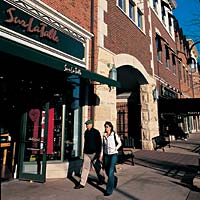 |
|
Strolling along Naperville’s |
A nine-mile wall of sprawl stretches south from I-88 along Highway 59, the western edge of Naperville. This seemingly endless string of strip malls, big-box stores, parking lots, subdivisions, and cornfields that sprout for-sale signs is a post card from the cluttered edge of suburbia. Most of this strip lies in Sector G, Naperville’s huge southwestern bulge that developed primarily in the 1990s. In a decade, this part of Naperville gained new homes for some 40,000 people and a dizzying array of chain stores and restaurants.
The stores can be useful, of course, but their bland boxiness and their big aprons of parking lots do nothing to distinguish Naperville from any other fast-growing town in America. “It’s mile after mile of monotony,” says Richard Furstenau, a Naperville city councilman since 1999 and a resident since 1977. “[Route] 59 is nothing more than a big old highway between strip malls; that affects your feeling about having a local, hometown place.” It happened, he says, because even for Naperville, the 1990s were too much to handle. “We made mistakes,” he says. “We needed business and shopping down on this side of town for all the new people coming in, but we didn’t keep enough control over how it got built. But we’ve put the brakes on.”
In the past few years, the city council has instituted requirements that specify mostly-brick construction, upgrade the landscaping standards at shopping centers, and otherwise tighten the aesthetic standards for new commercial and retail development. A second city center is developing around the intersection of Highway 59 and 95th Street, with two major anchors-Neuqua Valley High School and the dramatically contemporary 95th Street branch of the city’s esteemed library system. In keeping with the city’s new bigness, each institution easily dwarfs its counterpart in the center of town.
Nearby, on one of the last large undeveloped parcels on Highway 59, the developer Stephen Subach is building a 75-acre project called Naperville Crossings. The Crossings will have offices as well as residential, restaurant, and retail spaces, all laid out in a gently urban style reminiscent of the downtown area, but slightly larger. When complete in 2010, the development will feature tree-shaded walkways along a lake, a landmark local barn and a Victorian plant conservatory from Pittsburgh (both reassembled on the site); a mammoth multiscreen movie theatre; sculptures; and other attractions. It’s designed to be walkable and welcoming, the kind of place where you might while away most of a day. “I’m plagiarizing downtown Naperville,” Subach says.
Like so many before him, Subach got to Naperville knowing little about it. Based in Elmwood Park, he specializes in developing excess cemetery land, largely in Chicago. A buddy tipped him off to a valuable piece of property in Naperville, so he drove into town and took a look. Then he caught sight of downtown Naperville and, as he says, “I wanted more of that, but down here on 59.”
He set to work on the plans, and along the way Naperville worked its wiles on Su-bach. Now, though Steve has lived in Elmwood Park for 30 years-and his wife, Pamela, for 44-the Subachs are looking for a house to buy in Naperville.
Learning from Itself
Out of Many, One
Heart Beat



